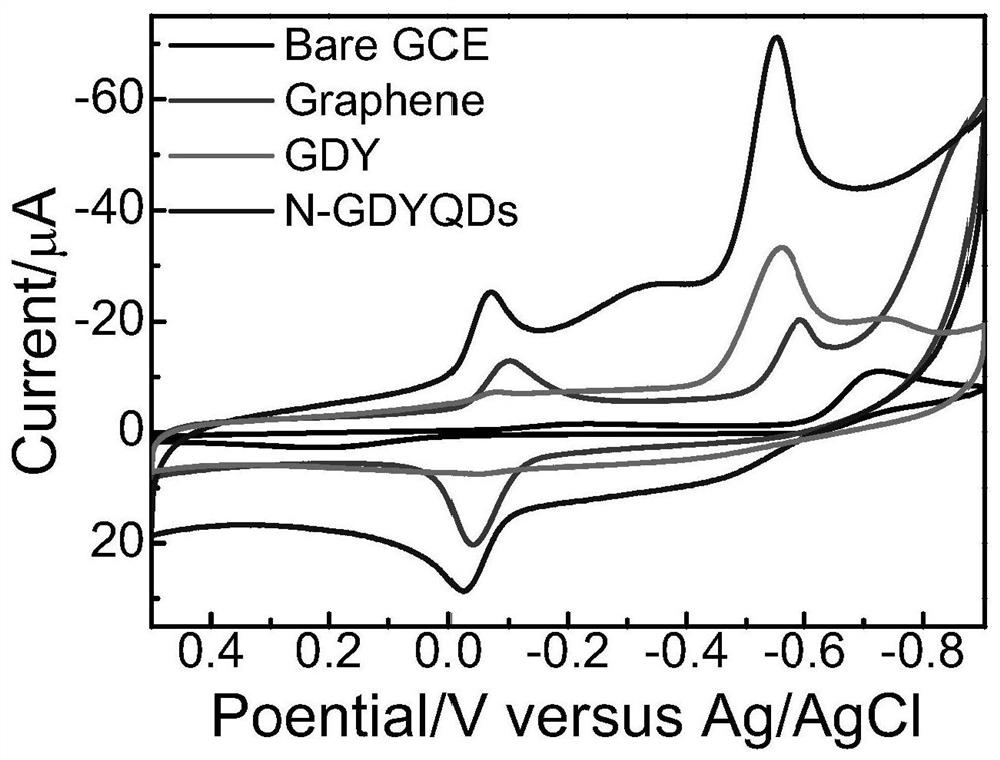Application of nitrogen-doped graphdiyne quantum dots in chloramphenicol detection
A technology of alkyne quantum and nitrogen doping, applied in the field of bioelectrical analysis and detection, can solve the problems of poor stability, high cost, and reduced advantages
- Summary
- Abstract
- Description
- Claims
- Application Information
AI Technical Summary
Problems solved by technology
Method used
Image
Examples
Embodiment 1
[0041] Preparation of N-GDYQDs and preparation of electrode material dispersant solution
[0042] 1. Preparation of N-GDYQDs
[0043] 0.25mg / mL graphyne aqueous solution (GDY) was ultrasonically treated for 3h, and the ultrasonic power was 400W to obtain a small-sized fragmented GDY dark brown solution; ) mixed (volume ratio 2:1) ultrasonic treatment for 30 minutes, ultrasonic power 400W, transferred to the reaction kettle 180 ℃ water heating for 8 hours to obtain a uniform yellow solution, and then dialyzed the gained yellow solution (the molecular weight cut-off of the dialysis bag is 500Da) 3 day, change the water every 8 hours, freeze-dry to get N-GDYQDs, attached figure 1 Its electron microscope picture shows that the nitrogen-doped graphyne quantum dot N-GDYQDs has a particle size of 2-5 nm.
[0044] 2. Preparation of N-GDYQDs electrode material dispersant solution
[0045] Add 750 μL of deionized water and 200 μL of absolute ethanol solution to 2 mg of N-GDYQDs, soni...
Embodiment 2
[0048] Comparison of electrochemical performance of different electrochemical sensing materials
[0049] The electrocatalysis of 500 μmol / L chloramphenicol standard solution based on different electrode materials (glassy carbon (GC), graphene (Graphene), graphyne (GDY), nitrogen-doped graphyne quantum dots) was tested by cyclic voltammetry performance. Various electrode materials were made into dispersants with a concentration of 2 mg / mL (the preparation method of the dispersant was the same as that of the dispersant in Example 1), and 6 μL of different electrode material dispersants were drip-coated on the same glassy carbon working electrode successively. (clean the electrode after each use), and form a three-electrode system with a platinum wire electrode and an Ag / AgCl electrode to form an electrochemical sensor. In the potential range of 0.5~-0.9V, the sweep speed is 50mV / s, the amplitude is 0.05V, and the pulse width is 0.05s. The electrochemical performance of the stan...
Embodiment 3
[0051] Evaluation of Electrochemical Performance of N-GDYQDs
[0052] The electrochemical performance of the electrochemical sensor based on N-GDYQDs modification was tested by electrochemical workstation CHI760, and the electrochemical sensing signal was tested by differential pulse voltammetry.
[0053] Take 6 μL of the N-GDYQDs electrode material dispersant prepared in Example 1 and drop-coat it on a glassy carbon electrode with a diameter of 0.5 mm. After drying at room temperature, use it as a working electrode modified with N-GDYQDs. The / AgCl electrode forms a three-electrode system electrochemical sensor, and the concentration of measuring pH is about 7 and is the DPV electrochemical signal of the phosphate buffer solution (prepared in embodiment 1) of 5000 μ mol / L chloramphenicol, and the DPV test potential range is-0.2~ -1V, the amplitude is 0.05V, and the pulse width is 0.05s. It can be found that when chloramphenicol is added to the solution, the DPV test has an o...
PUM
| Property | Measurement | Unit |
|---|---|---|
| Particle size | aaaaa | aaaaa |
Abstract
Description
Claims
Application Information
 Login to View More
Login to View More - R&D
- Intellectual Property
- Life Sciences
- Materials
- Tech Scout
- Unparalleled Data Quality
- Higher Quality Content
- 60% Fewer Hallucinations
Browse by: Latest US Patents, China's latest patents, Technical Efficacy Thesaurus, Application Domain, Technology Topic, Popular Technical Reports.
© 2025 PatSnap. All rights reserved.Legal|Privacy policy|Modern Slavery Act Transparency Statement|Sitemap|About US| Contact US: help@patsnap.com



